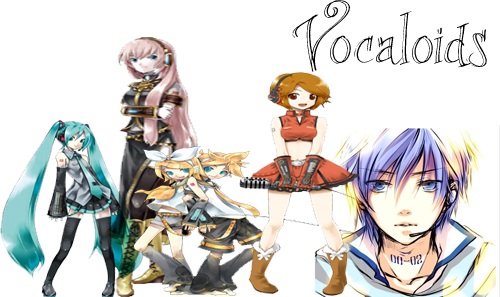

You may or may not have heard of a vocaloid before, and even if you have you may still be unsure as to what exactly the word ‘vocaloid’ means. So what does the word Vocaloid mean? Vocaloid and Vocaloid2 are voice synthesizing applications based off vocal fragments extracted from human singers and voice actors. Originally released in 2004 it has since taken the world by storm, spawning merchandise, anime, manga and even live shows. Each voice application is represented by a character, some of which we’re here to introduce you to today…
Hatsune Miku, developed by Crypton Future Media Inc, is probably the most popular and best known Vocaloid character and is often assumed to be the first to have been created, when in reality it was the English speaking Vocaloids Lola and Leon, though the English speaking vocaloids tend to not be as popular as their Japanese counterparts. Whether you know what a vocaloid is or not, chances are you’ll recognise the iconic turquoise pigtailed character one way or another, be it through various plushies, figures and other merchandise based on her image or through manga, anime or fan-art. Her name translates as ‘the first sound from the future’, to match her creators ideas that she should be released as ‘an android diva in the near-future world where songs are lost’.
Following shortly after Miku came the Japanese language Kagamine Twins; Rin and Len. Their voices, being based off the same voice provider, successfully harmonise with each other and as such they are often used in duets together. Like Miku their voices sound young, matching their character design whose concept was to be of a girl and her mirror image of the opposite sex. Crypton did not decide to announce the characters to be siblings or lovers so as not to tie down each user’s creativity. Their names are said to be based off ‘Left’ and ‘Right’, while the name ‘Kagamine’ translates to mean ‘Mirror sound’.
Megurine Luka differed from Miku, Rin and Len in the sense that her character was older and she was designed to sound more mature than her predecessors, designed to handle moodier genres such as Jazz. She was also marketed as a Japanese/English bilingual vocaloid, the translation of her name ‘songs to all around the world as scent spreads’ suggesting the intention to have Luka serve as a bridge between the English and Japanese languages.
Meiko was the first Japanese Vocaloid created utilising the older Vocaloid engine developed by YAMAHA. Until the creation of Luka she was the most mature sounding vocaloid female. Her voice was suited to most genres, being used to sing anything from pop, rock, jazz, R&B and even children’s song. Unlike the vocaloid2 creations to follow her name is that of the singer whose voice was used to create her.
Kaito was created as a counterpart of the vocaloid Meiko and was the first Japanese Male vocaloid to be released. He was named Kaito as it was viewed as a name that would be easy for non-Japanese speakers to pronounce and for the fact it looked to fit with the name Meiko. Much like his female counterpart Kaito is suited for most genres of music, though it is noted that he is best for singing pop ballads.
If the massive array of merchandise available and the different media in which these characters star in wasn’t enough to convince you of their popularity, then what of the attendance of their ‘live’ shows? That’s right; the vocaloids even have their own concerts, the characters appearing on-stage as rather impressive holograms. Even if you’re not a fan of the music the show is a must see, putting the 3D we see in cinema’s to shame!
All hail the vocaloids!











